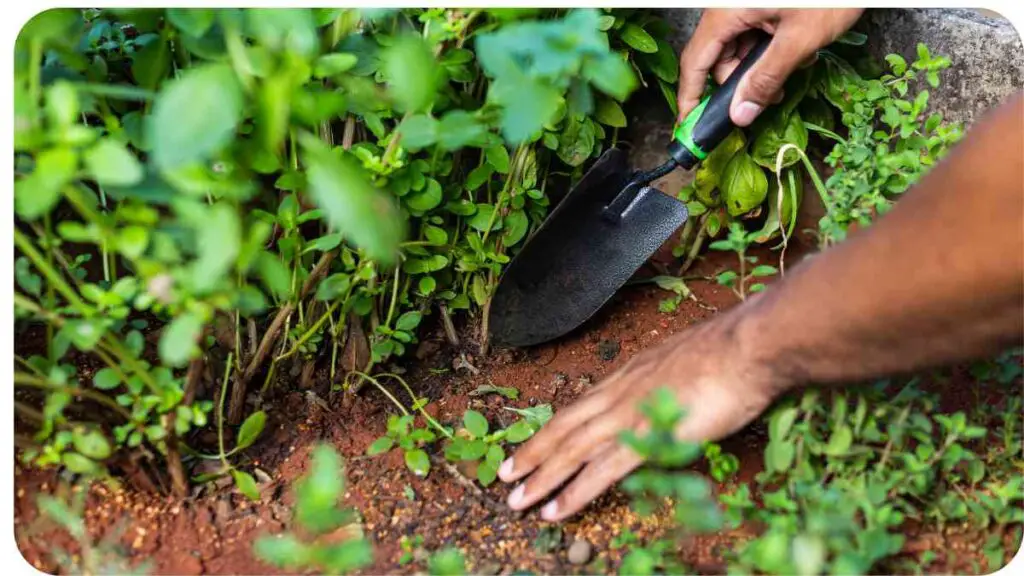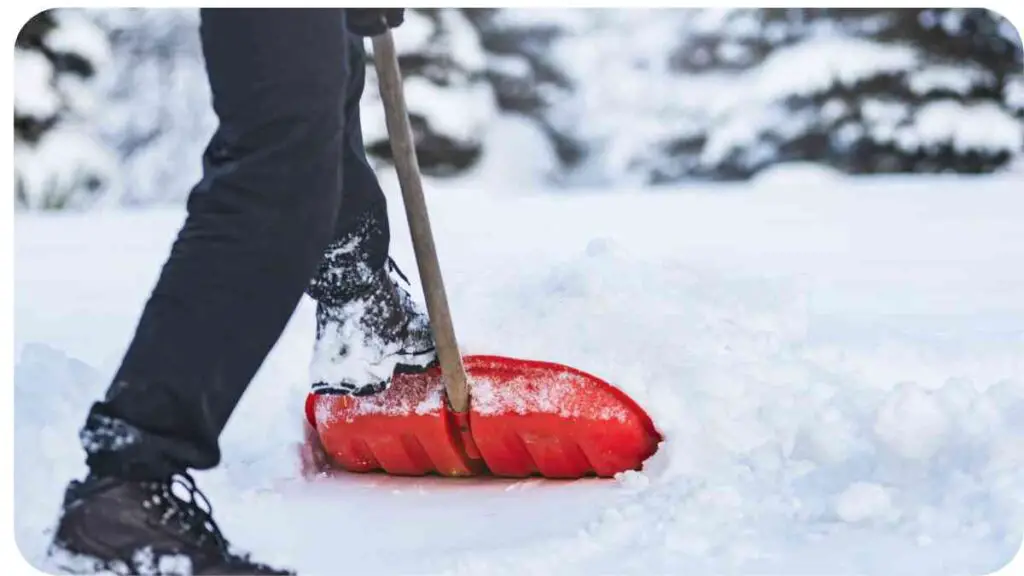Selecting the perfect shovel is pivotal for every gardener. In this guide, we delve into the diverse world of shovels, providing insights on their types and optimal uses.
Unearth the key to efficient garden work as we explore the best tools for various tasks, from digging and planting to edging and beyond.
| Takeaways |
|---|
| The right shovel can make your garden tasks easier and more efficient. |
| Digging shovels are best for general-purpose digging and moving soil. |
| Spades are ideal for edging, cutting roots, and creating straight lines. |
| Transplanting shovels are designed for moving plants and delicate roots. |
| Trowels are useful for small-scale digging, planting bulbs, and weeding. |
| Trenching shovels have a narrow, pointed blade ideal for digging trenches and ditches. |
The Versatile Basic Shovel
A fundamental tool in any gardener’s inventory, the basic shovel boasts unparalleled versatility, making it a wise investment for enthusiasts. Its utility spans from simple digging to lifting and moving heavy items, scraping away debris, or even clearing ice from walkways.
Crafted with a durable blade typically made from steel or iron and a handle fashioned from wood, plastic, or fiberglass, the basic shovel is readily available at hardware stores or garden supply centers.
Owning one is paramount for any yard work endeavor, as its myriad uses—from uprooting weeds to redistributing mulch—make it indispensable. Be prepared for any task that arises in your garden with this indispensable tool at your disposal.
Gardening involves the use of various tools, including shovels and gloves. To find out which gloves are best for gardening, check out our guide on what kind of gloves are good for gardening.
The Mighty Square-Point Shovel: A Garden Powerhouse

In the realm of garden tools, the square-point shovel emerges as a stalwart with its sharp, squared-off blade and a flat edge on the inside. A true chameleon in your gardening arsenal, it stands out as one of the most versatile implements in your shed.
This powerhouse is adept at a range of tasks, from digging through tough soils and prying up rocks and weeds to seamlessly shifting dirt to craft beds or pathways. Its precision and strength make it an indispensable companion for garden enthusiasts seeking efficiency and effectiveness.
Contrastingly, the round-point shovel, with its rounded belly, excels in moving materials such as soil or gravel, adept at creating tidy piles or relocating substances to designated areas. Together, these shovels form a dynamic duo, each with its unique strengths, contributing to a well-equipped and efficient gardening experience.
Square-Point Shovel Uses and Features
| Features | Uses |
|---|---|
| Sharp, squared-off blade | Ideal for digging through tough soils and rocky terrain |
| Flat edge on the inside of the shovel | Perfect for scraping, digging, and chopping |
| Versatile tool | Can be used for digging, prying up rocks and weeds, and moving dirt around |
| Suitable for creating garden beds and pathways | Helps to break up compacted soil and create new garden spaces |
| Comes in various sizes | Available in different lengths and widths to suit different gardening needs |
The Round-Point Shovel: Your Soil-Handling Maestro
A pivotal player in the gardening symphony, the round-point shovel takes center stage with its rounded blade, excelling at the triumvirate of digging, lifting, and soil movement. Perfect for crafting holes for planting or transplanting, this versatile tool effortlessly tackles weed removal.
Beyond its primary functions, the round-point shovel proves its worth by adeptly mixing soil and seamlessly scooping up dirt. In the absence of a wheelbarrow, it becomes your trusty companion, facilitating the efficient transport of garden waste back to the compost pile or garbage can.
This multifaceted tool is a gardener’s ally, seamlessly integrating into various tasks, ensuring that every movement of soil in your garden is executed with precision and ease. Add this soil-handling maestro to your gardening toolkit for a harmonious and efficient cultivation experience.
Round-Point Shovel Features and Uses
| Features | Uses |
|---|---|
| Rounded point blade | Ideal for digging and moving soil, as well as removing weeds |
| Curved shape | Helps to scoop up soil and other materials with ease |
| Versatile tool | Great for digging holes for planting, transplanting, mixing soil, and removing weeds |
| Suitable for gardening and landscaping | Offers flexibility in use for both gardening and landscaping projects |
| Comes in both long and short-handled varieties | Available in different lengths for different heights and garden types |
Shovels are just one of the many tools used in gardening. For a comprehensive list of gardening tools and their uses, check out our article on what are the tools of gardening.
The Precision Artisan: Unveiling the Edging Shovel’s Mastery
True to its name, the edging shovel emerges as a precision artisan, specifically designed for the meticulous craft of edging. Edging, an art in itself, involves the meticulous cutting or trimming of lawns, gardens, and flower beds to create a defined boundary between areas of varying heights.
While various techniques, such as using a string-line or manual trowel, prevail in the gardening realm, the edging shovel stands out as a singular tool dedicated to this task. Its unique design and sharp edge make it unparalleled in creating a crisp and visually appealing distinction between different sections of your garden.
For those enamored with the idea of achieving immaculate edges without the need for an array of tools, the edging shovel is your steadfast ally. Give this specialized tool the attention it deserves, and watch as your garden transforms into a meticulously curated masterpiece.
The Serrated Shovel: Unleashing Versatility in Tough Terrain
Meet the serrated shovel, a true multitasking marvel, designed for conquering the challenges of robust terrains. This powerhouse excels in digging into tough ground, effortlessly slicing through roots, sod, rocks, and even formidable tree stumps.
Beyond its prowess in excavation, the serrated shovel proves its mettle in the garden’s dynamic landscape. It becomes a reliable ally in the intricate task of cutting shrubs, bushes, and when the need arises, eliminating trees to reshape your garden or yard.
With its serrated edge, this tool is not just a shovel; it’s a versatile solution for gardeners navigating diverse and demanding terrains. Add the serrated shovel to your arsenal, and witness its transformative impact in turning challenging gardening endeavors into manageable triumphs.
Fertilizing is a critical aspect of gardening that can help your plants grow and thrive. If you’re wondering how to fertilize your lawn yourself, head over to our guide on how do I fertilize my lawn myself to learn more.
The Drain Spade: Mastering Precision in Shallow Excavations
The unassuming yet indispensable Drain Spade emerges as a garden virtuoso, featuring a flat, broad blade tailored for digging shallow holes with finesse. Its sharpened end transforms it into a versatile tool, seamlessly transitioning into roles as a hoe or mattock.
This specialized shovel shines in the meticulous task of removing soil from around the roots of plants and shrubs, ensuring minimal disruption to delicate root systems. Beyond root care, the Drain Spade proves its worth in crafting drainage ditches, effortlessly cutting through hardpan areas that challenge water drainage. Additionally, it becomes an ally in breaking up sod when preparing lawns, garden beds, and flowerbeds.
With precision and efficiency, the Drain Spade becomes an indispensable companion for gardeners navigating tasks that demand both finesse and strength in equal measure. Integrate this tool into your garden routine and witness its transformative impact on your landscaping endeavors.
Snow Shovels: Winter Warriors in Your Garden Arsenal

Snow shovels, the unsung heroes of winter, stand ready to combat the icy challenges that cloak your walks, steps, and driveways. Their versatile design makes them indispensable for tasks ranging from clearing pathways to digging out snow-trapped cars and even addressing the snow accumulation on roofs.
Distinguished by a rectangular blade, wider than it is long, snow shovels come in various materials to suit different preferences and needs. The most prevalent types feature solid steel or aluminum construction, ensuring durability and reliability in the face of winter’s relentless onslaught. For those favoring lightweight options, plastic or fiberglass variations are readily available, offering a blend of efficiency and ease of use.
As the winter warriors in your garden arsenal, snow shovels are your trusted companions in the battle against the elements, ensuring safe and accessible outdoor spaces during the chilly months. Choose the one that aligns with your needs, and let your snow shovel become the beacon of order in the midst of winter’s frosty chaos.
A lawn roller is a tool that can help you maintain a healthy lawn. To learn more about how to fill a lawn roller correctly, check out our article on how do you fill a lawn roller explained.
Scoop Shovels: Lightweight Prowess for Effortless Gardening
For those seeking a nimble and user-friendly garden companion, the scoop shovel emerges as the epitome of lightweight efficiency. Crafted with the intention of making digging, scooping, and edging a breeze, scoop shovels are often constructed from materials like aluminum or fiberglass.
Their ergonomic design and reduced weight make them an ideal choice for various tasks. One common application is the excavation of trenches in the ground, where the scoop shovel’s agility shines. Another notable use is in planting bulbs or transplanting plants into the garden soil, where the scoop shape facilitates precise and controlled movements.
Whether you’re a seasoned gardener or a novice enthusiast, the scoop shovel’s ease of use and versatility make it a must-have tool. Embrace the convenience it offers as you navigate your gardening journey, transforming tedious tasks into enjoyable and efficient endeavors.
Posthole Diggers
Posthole diggers are used to dig holes for fence posts, railroad ties and other posts that are larger than 3 inches in diameter. Posthole diggers have a flat blade and a pointed tip. They are usually made of steel but can also be made from plastic.
Feeding your garden is an essential aspect of gardening that can impact plant health and growth. To learn how to use the Miracle-Gro garden feeder, check out our guide on how often should you use Miracle-Gro garden feeder and follow our easy steps.
Clam or Scallop Shovels: Precision Diggers for Delicate Spaces
Enter the clam or scallop shovel, a specialized tool designed for precision in digging and planting, particularly in confined and intricate spaces. Distinguished by their small blades, these shovels excel in working around delicate plants like flowers and shrubs, ensuring minimal disturbance to their surroundings.
One of their standout features is their ability to create holes for planting bulbs with finesse. The compact design of clam or scallop shovels allows for comfortable and efficient use, enabling gardeners to access any area without excessive bending.
Embrace the elegance of these precision diggers, where functionality meets finesse. Whether you’re tending to a garden full of blooms or carefully planting bulbs, clam or scallop shovels offer a gentle touch and ease of use that elevates your gardening experience.
Garden Trowel: The Small-Scale Maestro
A garden trowel, a diminutive yet essential tool, is the maestro of small-scale digging and planting. Easily sourced at most gardening stores, including reputable outlets like Home Depot and Lowe’s, these versatile implements are also affectionately known as dibbers due to their historical role in creating holes for bulbs and seeds.
Crafted from a variety of materials such as metal, wood, or plastic, the best garden trowel boasts a pointed tip, facilitating easy soil penetration for planting small plants or creating holes. Its precision extends to weed removal from garden beds, ensuring a tidy and well-maintained planting space.
When selecting a garden trowel, prioritize comfort by opting for a model with a well-designed handle, especially if crafted from metal. This ensures an ergonomic grip, preventing hand strain during extended gardening sessions. Elevate your small-scale planting endeavors with the precision and ease offered by a well-chosen garden trowel.
Conclusion
In the vast landscape of gardening tools, the right shovel can be the key to unlocking efficiency and precision in your garden endeavors. We’ve taken you on a journey through various types of shovels, each tailored to specific tasks and landscapes.
Whether you’re navigating tough soils with a square-point shovel, creating crisp edges with an edging shovel, or delicately planting with a clam or scallop shovel, the choices are vast. Embrace the winter challenges with a reliable snow shovel or make small-scale magic happen with a garden trowel.
If you find yourself pondering which shovel is the perfect fit for your gardening needs, fear not. Our guide aims to empower you with the knowledge to make an informed decision. Should questions arise or guidance be sought, don’t hesitate to reach out. Your gardening journey is our priority, and we’re more than happy to assist at any time.
Equip yourself with the right shovel, and let your gardening aspirations flourish with newfound ease and effectiveness. Happy gardening!
Further Reading
Here are some additional resources on shovels for gardening:
How to Choose the Right Shovel for Your Garden: This guide from Gardening Know How provides a detailed overview of how to choose the right shovel for your gardening needs.
Types of Shovels for Gardening: Here, Trees.com explores the various types of shovels available for gardening and landscaping.
Types of Shovels for Gardening: Which One Do You Need?: Backyard Boss offers a comprehensive guide to different types of shovels for gardening, including digging, trenching, and transplanting shovels.
FAQs
Q: What are the different types of shovels used for gardening?
A: Some common types of shovels used for gardening include digging shovels, spades, transplanting shovels, trowels, and trenching shovels.
Q: What should I consider when choosing a shovel for gardening?
A: When choosing a shovel for gardening, consider the size and shape of the blade, the length and weight of the handle, and the material used to make the blade and handle.
Q: How do I maintain my garden shovel?
A: To maintain your garden shovel, clean it regularly, sharpen the blade as needed, and store it in a dry place away from moisture.
Q: How do I use a garden shovel?
A: The technique for using a garden shovel will depend on the type of shovel and the task at hand. However, in general, you should grip the handle with both hands, step on the top of the shovel blade to drive it into the soil, and use the leverage of the handle to lift soil, rocks, or other debris.
Q: Can I use a garden shovel for other purposes besides gardening?
A: Yes, garden shovels can be used for a variety of purposes outside of gardening, such as digging holes for fence posts or mixing concrete. However, keep in mind that using a garden shovel for non-gardening tasks may cause the blade to become dull or the handle to break over time.

Hi! My name is Hellen James, and I’m here to help you with your home-maintenance needs. Whether it’s building a better yard or just trying to fix a garden—I can show you how.


